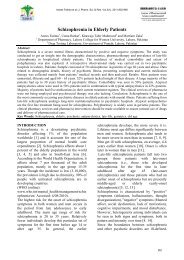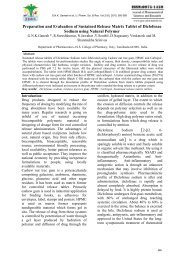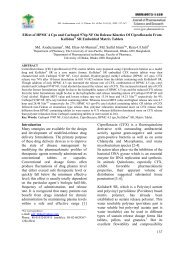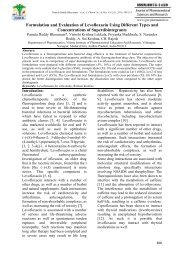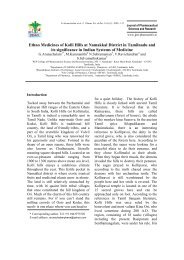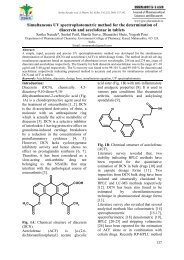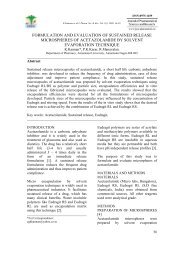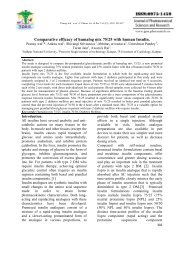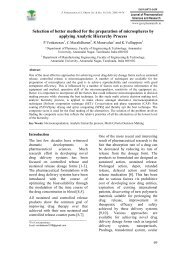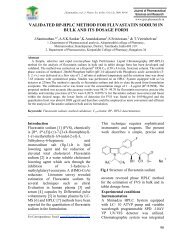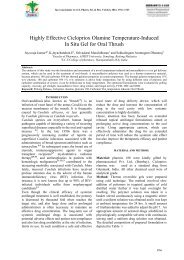Pharmacognostical standardization of leaves of Ixora coccinea, linn.
Pharmacognostical standardization of leaves of Ixora coccinea, linn.
Pharmacognostical standardization of leaves of Ixora coccinea, linn.
You also want an ePaper? Increase the reach of your titles
YUMPU automatically turns print PDFs into web optimized ePapers that Google loves.
R. Vadivu et al, /J. Pharm. Sci. & Res. Vol.2(3), 2010, 164-170<br />
chemical tests for various extracts were also<br />
carried out according to the standard<br />
procedures described by Kokate[11] and<br />
Horborne[12].<br />
Results:<br />
Macroscopy<br />
The plant is a dense, multi – branched<br />
evergreen shrub, commonly 4-6 ft (1-2-2m)<br />
in height , but capable <strong>of</strong> reaching up to 12ft<br />
(3.6 m). Leaves are oblong are about 10cm<br />
long , with entire margins and are carried in<br />
opposite pairs or whorled on the stem. They<br />
are sessile to short – petiolate, blades<br />
elliptic, oblong or obovate, usually leathery,<br />
base cordate to rounded, apex rounded ,<br />
mueronate or shortly tapering ; stipules<br />
basally sheathing , lobes Triangular and<br />
strongly acon – tipped. Flowers sessile;<br />
calyx lobes short, triangular, persistent ,<br />
corolla tube usually 1-1.5 inches long , lobes<br />
lanceolate to ovate, less than 0.25 inches<br />
long , acute or sometimes obtuse fruit thinly<br />
fleshy , reddish black.<br />
Microscopic features <strong>of</strong> the <strong>leaves</strong><br />
Microscopical studies are useful to establish<br />
the botanical identity for the valuable herbal<br />
drugs, which forms the basis for the<br />
identification and determination <strong>of</strong><br />
adulterants.<br />
The leaf is dorsiventral, hypostomatic and<br />
mesomorphic. It has thick midrib projecting<br />
both adaxially and abaxially (fig 1).The<br />
midrib has adaxial broadly conical hump<br />
and wide semicircular abaxial past. The<br />
midrib is 1.1 mm thick. The adaxial past is<br />
400µm wide. The abaxial part is 900 µm<br />
thick.<br />
The epidermal layer <strong>of</strong> thin midrib consists<br />
<strong>of</strong> small, squarish, thick walled cells with<br />
prominent cuticle, the cells are with<br />
prominent cuticle and the cells are 22 µm<br />
thick. Beneath the adaxial hump is a small<br />
patch <strong>of</strong> angular, compact thick walled cells,<br />
the palisade layer <strong>of</strong> the lamina extend up to<br />
the lateral part <strong>of</strong> the hump (fig.2)<br />
The lower semicircular midrib has<br />
parenchymatous ground tissue. The cells are<br />
wide thin walled, angular and compact.<br />
Calcium oxalate are occasionally seen in<br />
some <strong>of</strong> the parenchyma cells (fig.4)<br />
The vascular system <strong>of</strong> the midrib consists<br />
<strong>of</strong> an adaxially flattened closed cylinder <strong>of</strong><br />
xylem and phloem ; with in the cylinder are<br />
two small rectangular segments <strong>of</strong> vascular<br />
bundles. The outer cylinder has a thin layer<br />
<strong>of</strong> xylem fibres and short radial files <strong>of</strong><br />
narrow, thick walled angular xylem<br />
elements and outer continuous zone <strong>of</strong><br />
phloem.<br />
Hedullary accessory bundles are collateral<br />
with xylem elements facing the adaxial side<br />
and phloem elements placed toward the<br />
centre. The vascular cyclinder is 170 µm<br />
thick. The xylem elements are 20µm wide.<br />
Lamina (Fig 5) : The lamina has wide ,<br />
radially oblong thick walled adaxial<br />
epidermis with prominent cuticle. The<br />
adaxial epidermis is 40 µm thick. The<br />
abaxial epidermis has comparatively small<br />
cells which are squarish in shape, the cuticle<br />
is thicker; stomata are present on the lower<br />
epidermis.<br />
These are two layers <strong>of</strong> palisade cells along<br />
the upper part. The cells are wide,<br />
cyclindrical and the palisade zone in 60µm<br />
in height. The spongy parenchyma cells are<br />
in 4 (or) 5 rows. They are large thin<br />
traveled, spherical lobed and form wide air –<br />
chambers (fig – 6)<br />
The vascular strands <strong>of</strong> the lateral veins are<br />
circular with thick cylinder <strong>of</strong> fibers and<br />
small central case <strong>of</strong> xylem and phloem.<br />
Quantitative microscopy<br />
Quantitative microscopy<br />
Quantitative microscopic data are found to<br />
be constant for a species. These values are<br />
especially useful for identifying the different<br />
species <strong>of</strong> genus and also helpful in the<br />
determination <strong>of</strong> the authenticity <strong>of</strong> the<br />
plant. The study <strong>of</strong> the leaf constants<br />
showed that the average stomatal number is<br />
165



